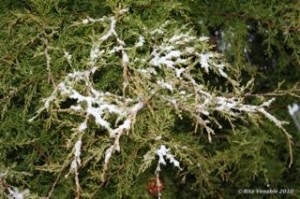The tree was spotted along the edge of a powerline mow just as the sun was going to bed at Land Between the Lakes in western Kentucky. The green of the Eastern red cedar tree stood out against the more subdued shades of gold and brown of the sleeping grasses and leafless oaks around it. So many trees had not “cut the mustard”—too tall, too skinny, or too close to the road or cemetery where cutting wasn’t allowed.
This one was different. Closer, closer, was there a side of it we didn’t see? Cedars will grow in some shade, but the best ones are in full sun and alone. If a cedar is part of a cluster, there is always one side that hasn’t developed because of the group.
Yes, at last, this was it! We measured, cut, and dragged the tree up the hill to the truck where it was tied down and loaded in to the sounds of coon dogs baying in the distance. We were thankful for this cedar, for finding it, and for finding it together. We were also thankful for the work gloves we brought to protect our hands from the needles.
The smell of cedar, clean and fresh, filled the truck. Since smell evokes the memory most, we should not have been surprised at the scenes that flowed in like slow creeks: quail-hunting along the Kentucky bottomlands, Juniper Hairstreak hunting in the Tennessee cedar glades, and toy hunting under our childhood Christmas trees.
Naturalist and author Pat Sutton writes about why the Eastern red cedar is so “right”: http://nativeplantwildlifegarden.com/red-cedar/ for the New England landscape and garden. Eastern red cedars are just as right for Tennessee. Plant them, smell them, and remember.
©Rita Venable 2011
